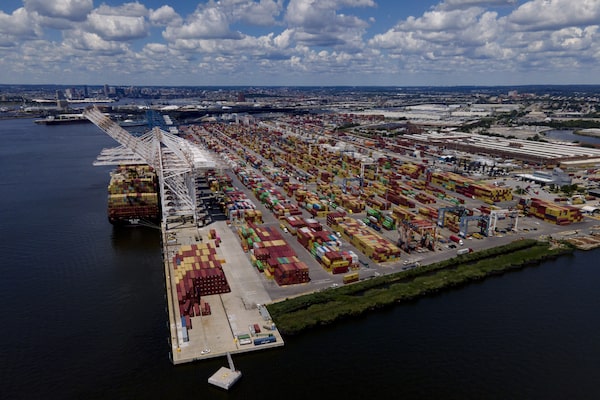
Shipping containers are stacked together at the Port of Baltimore, on Aug. 12.Julio Cortez/The Associated Press
The European Union and United States have ramped up buying key industrial metals from Russia, data showed, despite logistical problems spurred by the war in Ukraine and tough talk about starving Moscow of foreign exchange revenue.
The metal shipments highlight the West’s difficulty in pressuring Russia’s economy, which has performed better than expected and seen its ruble currency surge as buoyant oil revenue has helped offset the impact of sanctions.
EU and U.S. imports of Russia’s main base metal products aluminum and nickel during March-June increased by as much as 70 per cent, official trade data compiled by Reuters from the United Nations Comtrade database show.
The total value of EU and U.S. imports of the two metals from March to June were $1.98-billion, the data showed.
The West has imposed repeated waves of sanctions on a wide range of Russian products, people and institutions, but has largely spared the industrial metals sector.
A U.S. State Department spokesperson said in response to a query from Reuters: “Although we don’t preview our sanctions actions, nothing is off the table to increase the price on Putin’s unjustified war against Ukraine.”
The European Commission did not provide a comment after a request.
Analysts said the United States and Europe have learned lessons after huge disruption on construction, auto and power sectors caused by sanctions imposed by former U.S. President Donald Trump on Russian aluminum in 2018.
Those sanctions were lifted the following year.
Prices of both metals surged to record peaks shortly after Russia launched its invasion of Ukraine on Feb. 24 on fears that sanctions or difficult logistics would block shipments.
But those fears were unfounded, since the data show Russian exports during March to June were relatively strong.
“Market mechanisms are working,” said Julius Baer analyst Carsten Menke, referring to Russian metals shipments.
“We know from commodity traders it’s mainly a question of the price. It’s not so much about some politician not wanting you to buy, but is there a deal here.”
Russia’s Rusal is the world’s largest aluminum producer outside China and accounts for about 6 per cent of estimated world production.
During the four months following Russia’s invasion of Ukraine, the EU was the biggest importer of unwrought aluminum from Russia, pulling in an average of 78,207 tonnes a month in March-June, 13 per cent more than the same period last year.
Rotterdam, Europe’s largest port, said in a report total volumes rose 0.8 per cent in the first half of 2022, but “break bulk” – cargo that does not fit in containers – rose sharply by 17.7 per cent, driven by higher imports of metals.
A port spokesperson told Reuters that shipments of aluminum and nickel were still arriving in the port since they are not sanctioned, but declined to give any figures.
On Tuesday, a division of Norway’s Norsk Hydro said it would exclude Russian metal from deals to buy aluminum for 2023.
U.S. monthly imports of Russian aluminum averaged 23,049 tonnes in March-June, up 21 per cent from the same period last year.
“For the Americans, it’s very important that they get as many different aluminum sources as possible,” said Tom Price, head of commodities strategy at Liberum.
“They’re very reluctant to get any metal from China, where exports are shrinking, so Russian Rusal aluminum is very important, which is why they haven’t shut that trade down.”
Overall shipments have been relatively steady.
Russian aluminum imports to last year’s top seven destinations in March to June averaged 221,693 tonnes a month, 9 per cent less than the same period last year, but 4 per cent higher than the monthly average for all of 2021.
In nickel, Russia accounts for about 10 per cent of global output and the country’s Nornickel makes about 15 per cent to 20 per cent of the world’s battery-grade nickel.
Nickel imports from Russia by the top three destinations in March-June rose 17 per cent year-on-year.
The United States saw the biggest gains, surging 70 per cent compared with last year, while EU shipments gained 22 per cent.
A jump in prices following the invasion provided an extra incentive to continue exports, analysts said.
Benchmark nickel on the London Metal Exchange doubled to a record above $100,000 a tonne on March 8, prompting the LME to suspend trading and cancel deals.
Be smart with your money. Get the latest investing insights delivered right to your inbox three times a week, with the Globe Investor newsletter. Sign up today.